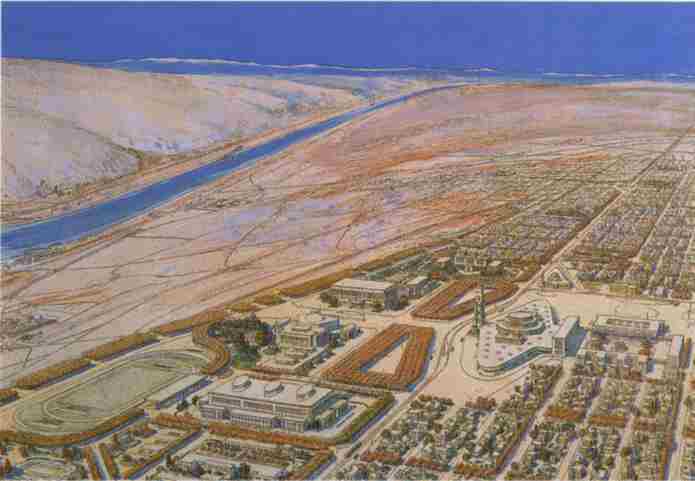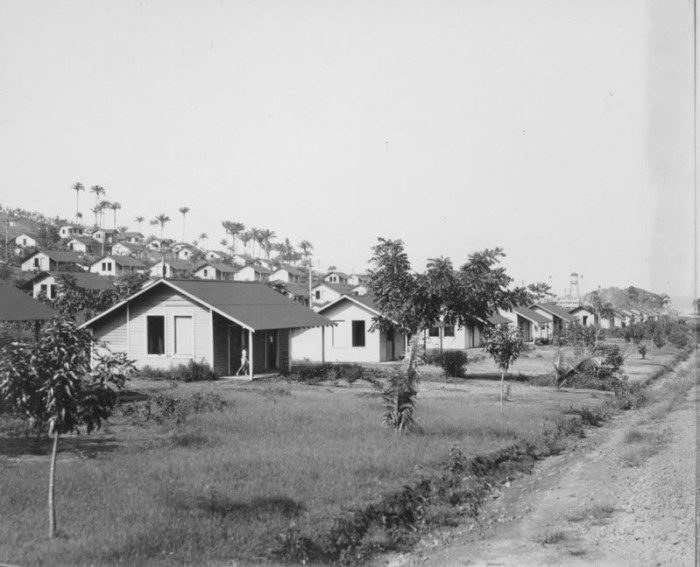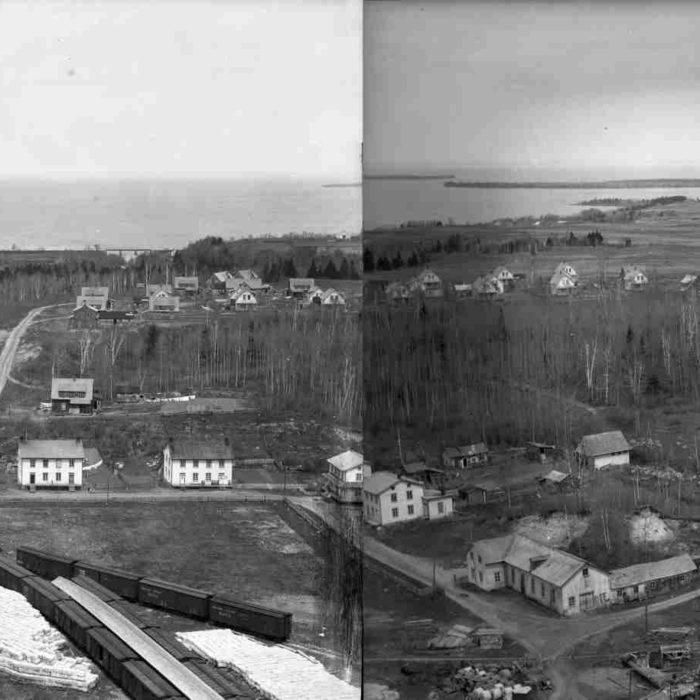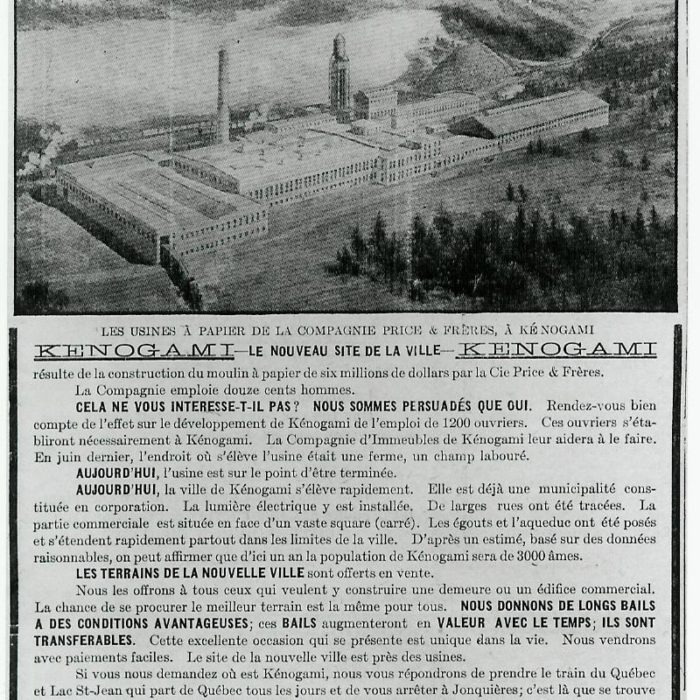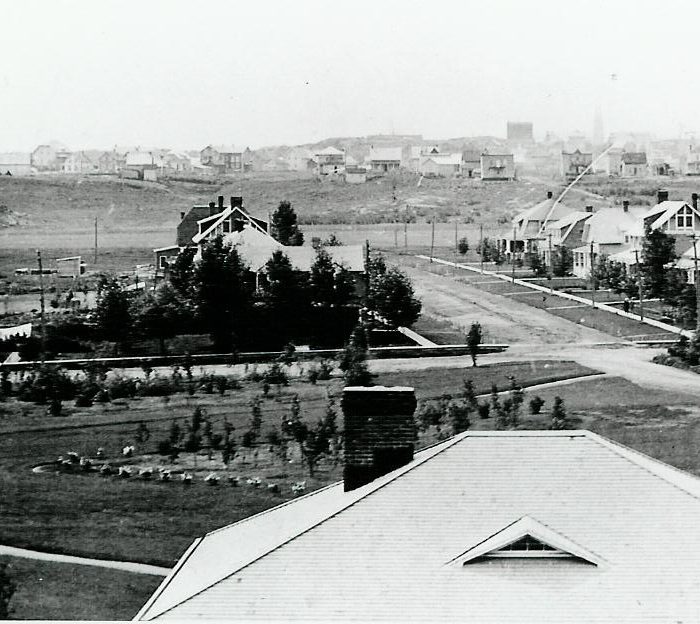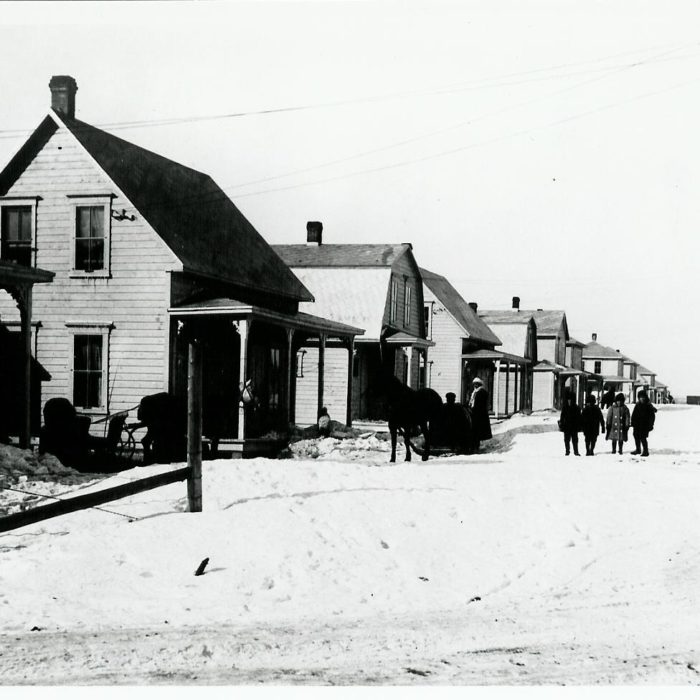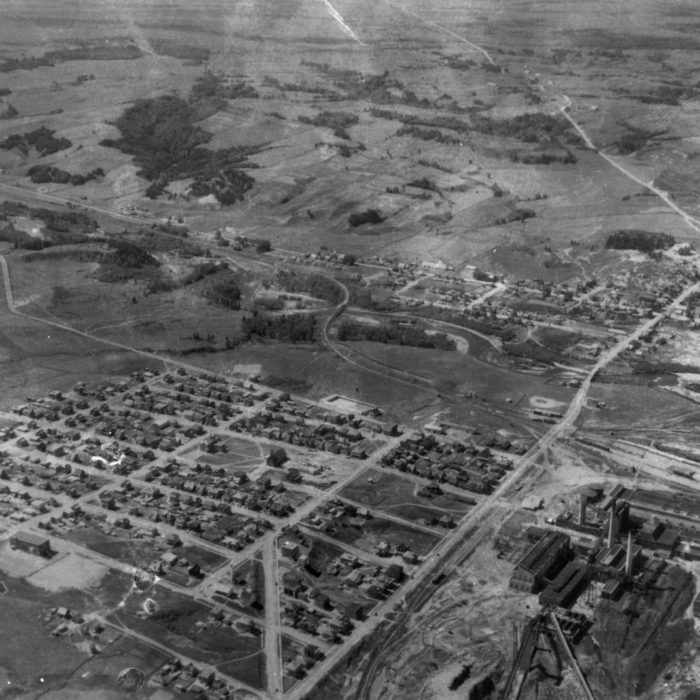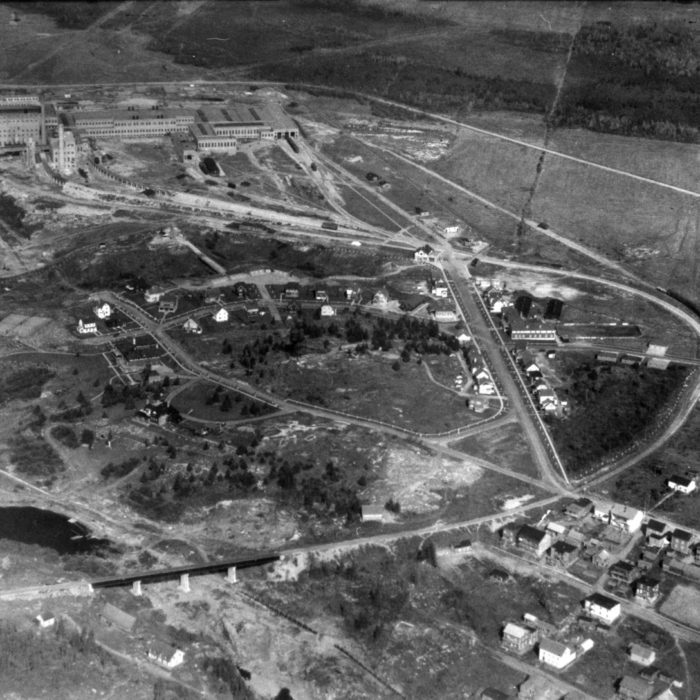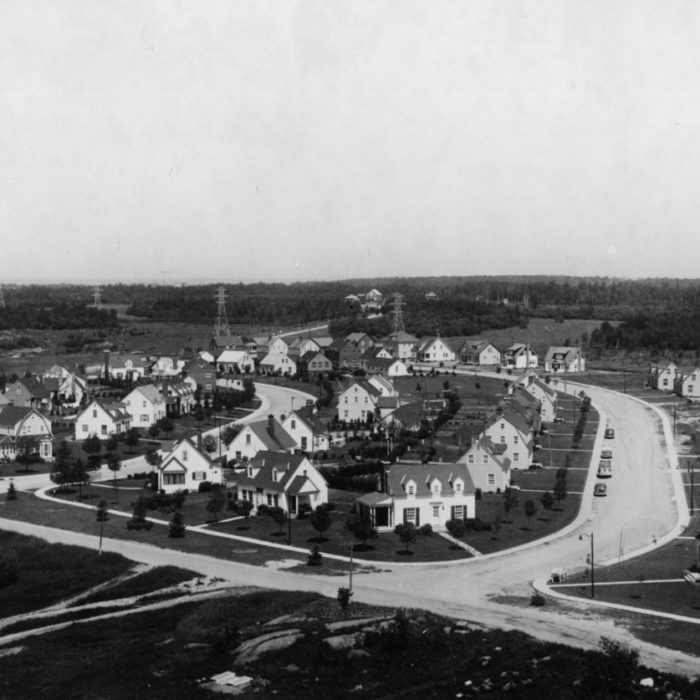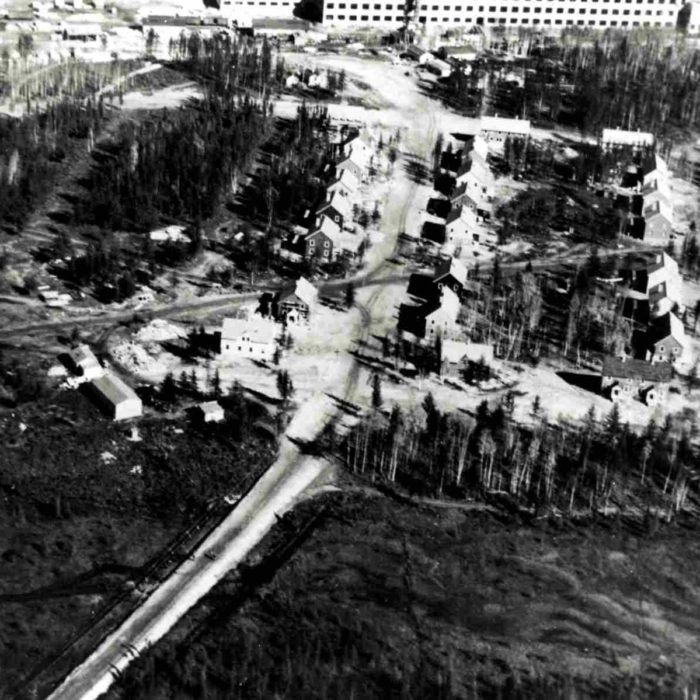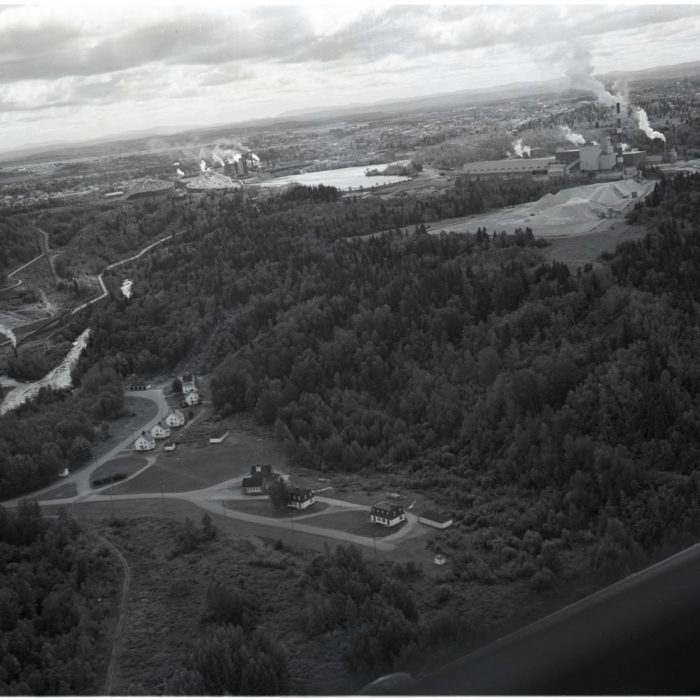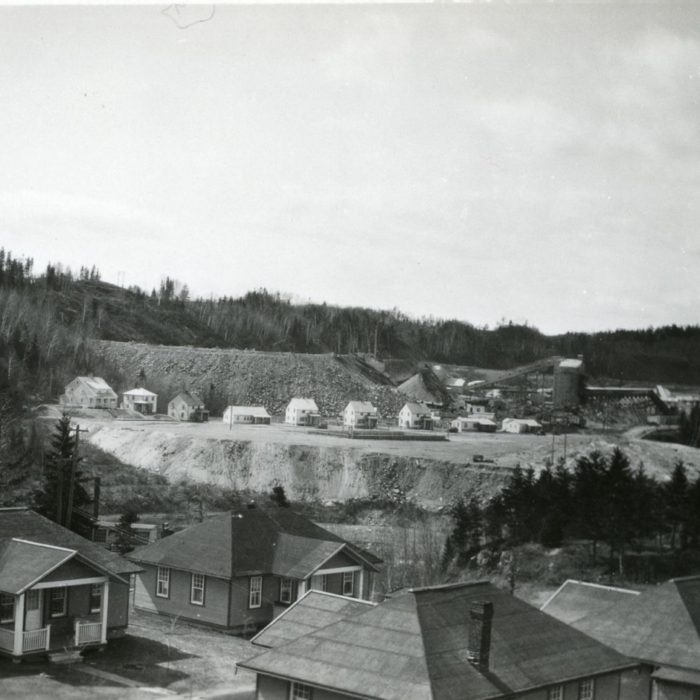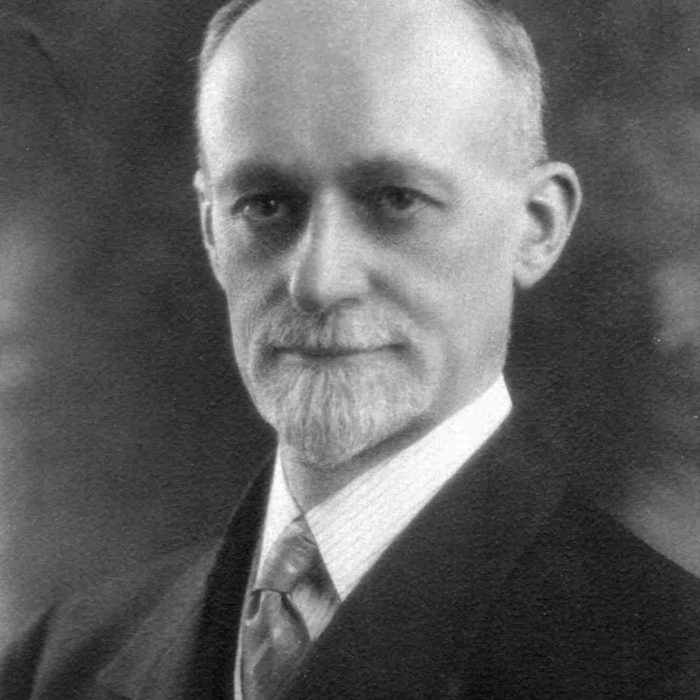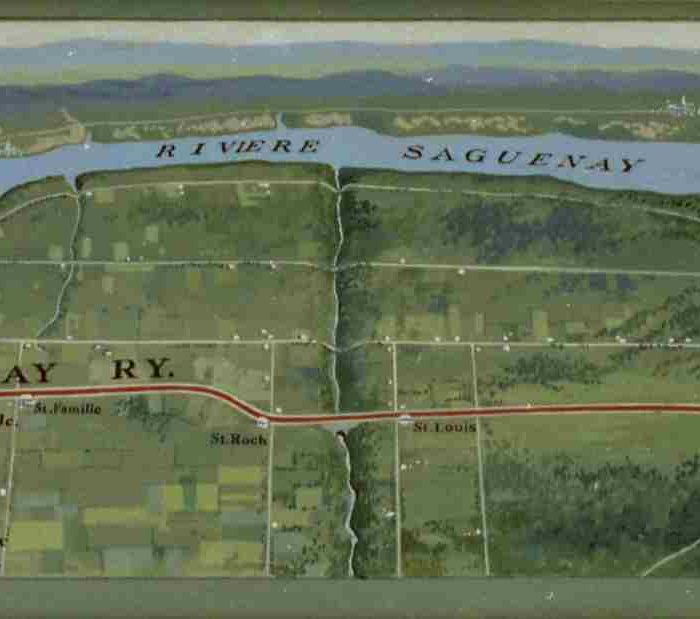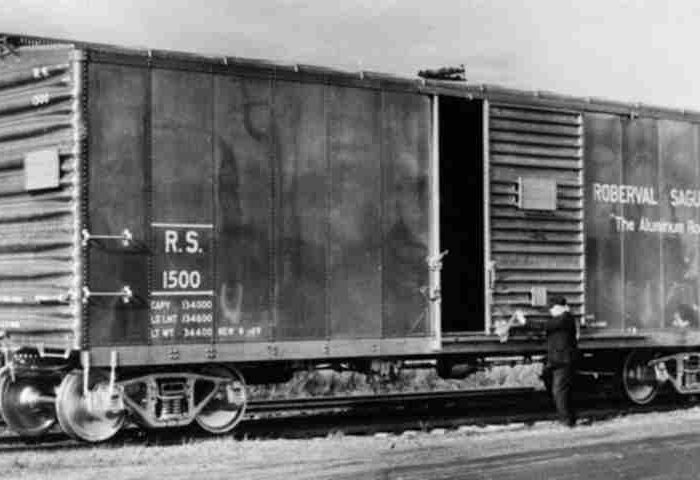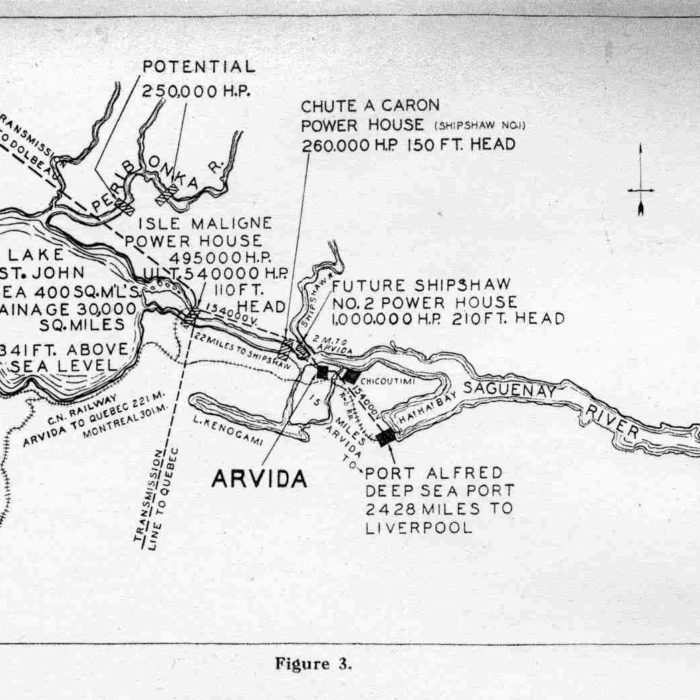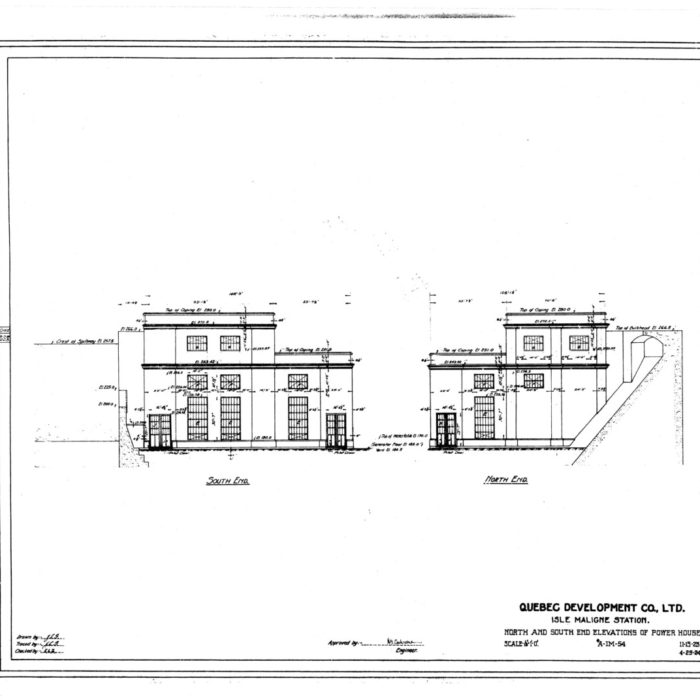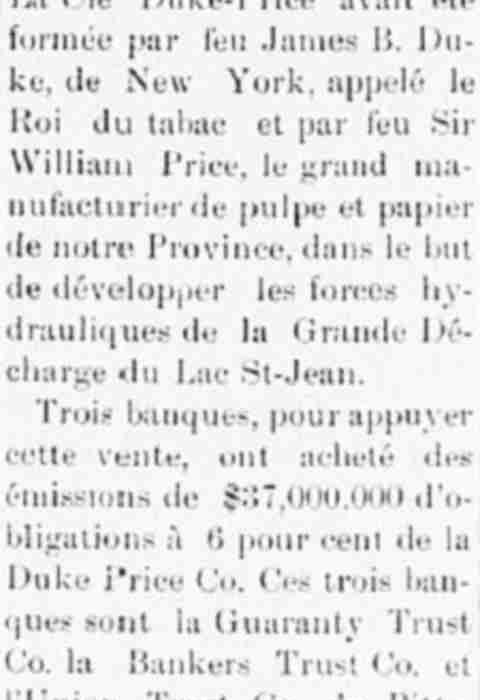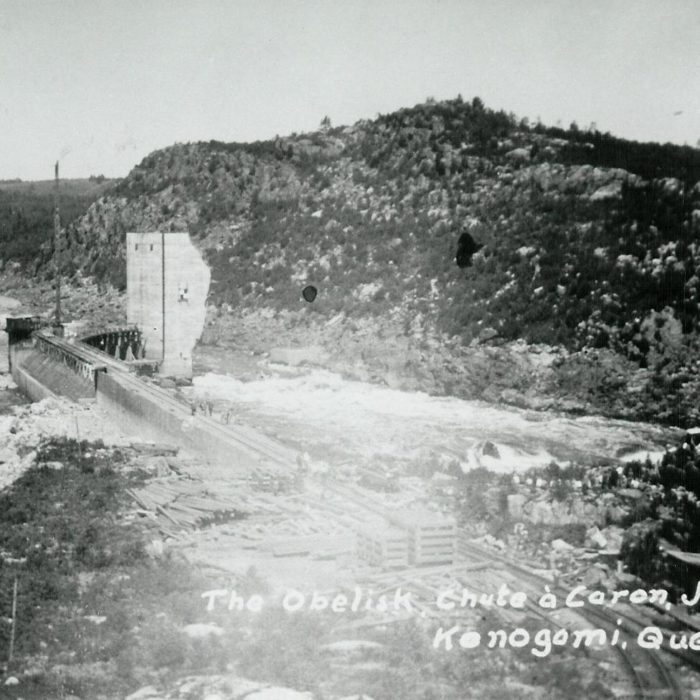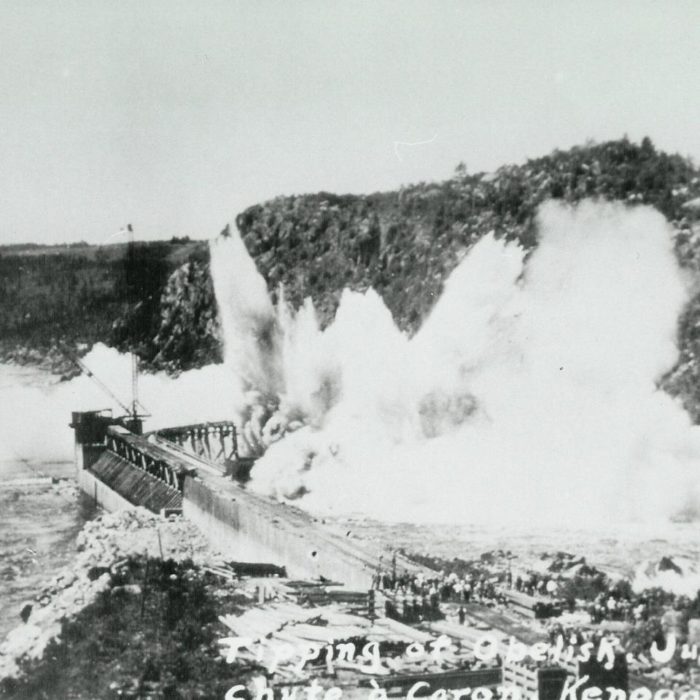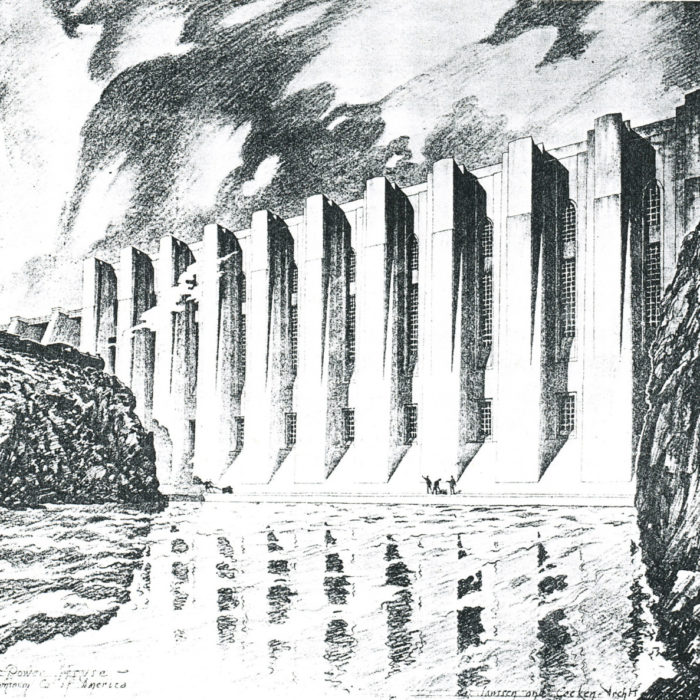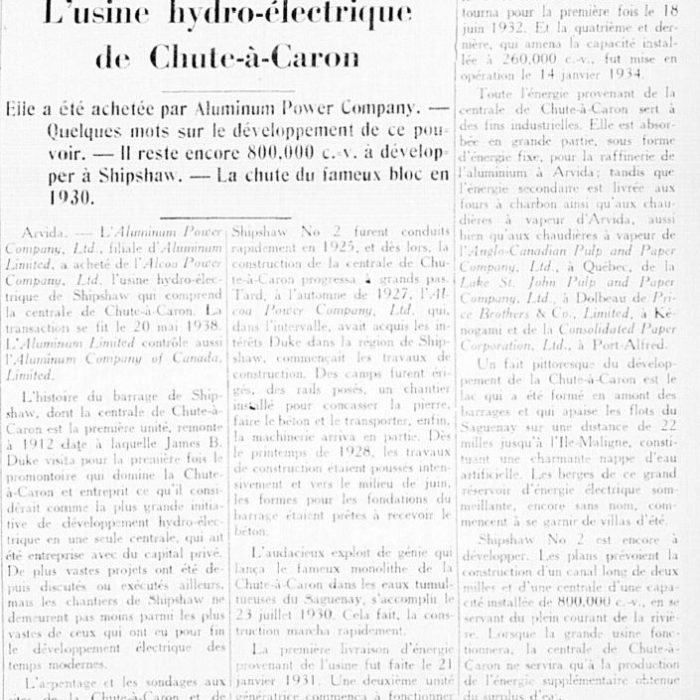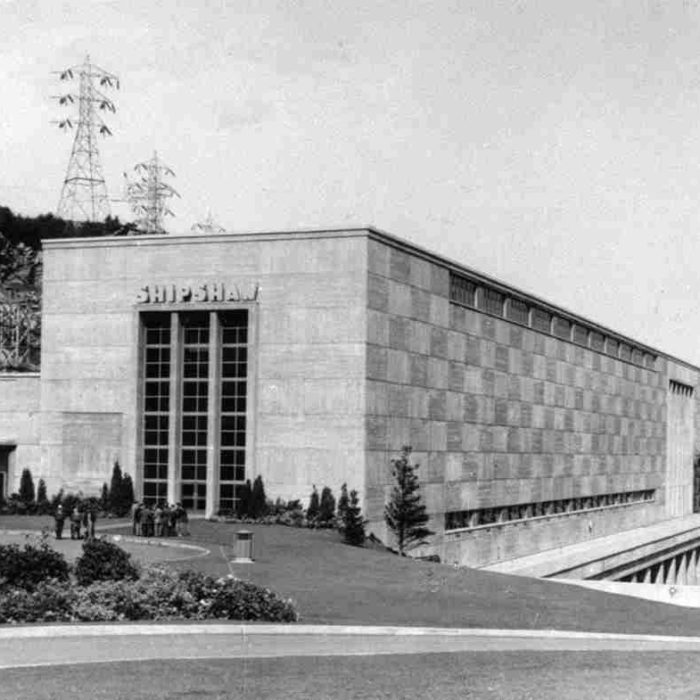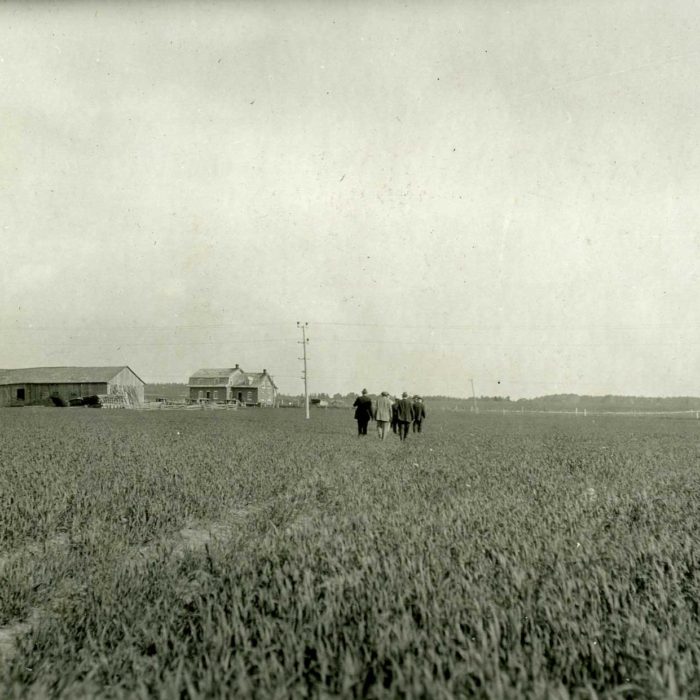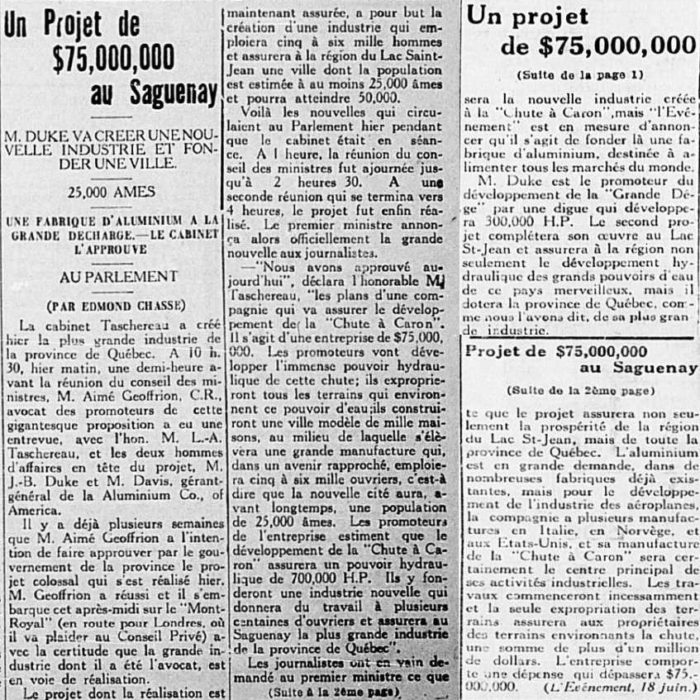A socio-industrial utopia
A planned industrial city, Arvida is born out of the desire of the Aluminum Company of America (Alcoa) to establish itself in the area, notably due to the region’s vast hydroelectric potential. Thus, the company acquires 6,000 acres of land (2,400 hectares) with the objective of building an aluminum metropolis of 25,000 to 50,000 residents. Created from scratch, the City of Arvida owes its design to Hjalmar Ejanas Skougor and Harry Beardslee Brainerd, and its name to the president of Alcoa, Arthur VIning DAvis. During the Second World War, Arvida is propelled on the world stage because of its aluminum smelter. Indeed, the great need for aluminum for the manufacture of war material leads to numerous expansions, both of the city and the factory. In 1943, the Arvida aluminum smelter is the world’s largest producer of aluminum, playing a key role in the Allied victory.
Nicknamed “The Washington of the North”, Arvida is exemplary among the planned company towns of the twentieth century. It is distinguished from others for several reasons, including the scope of its design, the sophistication of its urban planning as well as its social and cultural modernity. Arvida descends from a long urban tradition, representing the culmination of decades of architectural, social, economic and technological research on working-class housing, new towns and planned industrial cities. It embodies the utopian ambitions in the vision of “imagination without reality” in Cité Industrielle by the French urban planner Tony Garnier. The book, published in 1917, is the outcome of several urban planning theories developed in the wake of the Industrial Revolution in nineteenth-century Europe. Garnier carried out a study on the construction of cities. It is the design of a model city, ideal and self-sufficient. Tall buildings are excluded. The city is divided into districts according to purpose, such as work, housing, health and leisure. It is organized around work, where everything is planned for the well-being of the working-class residents.
It is in this vision of a new city that Arvida is created : a large, green, attractive and comfortable town where the single-family home is favoured. Arvida stands among socio-industrial utopias. Its creators, Alcoa, and later the Aluminum Company of Canada, have attempted to conceptualize an ideal society where it feels good to live.
A planned industrial city
Just like Alcoa’s managers, other industrialists are interested in the Saguenay–Lac-Saint-Jean region for its natural resources. Its vast forests and thousands of waterways attract other companies, leading to the establishment of several factories, often built in the wilderness. The administrators must therefore build residences to house the labour force as well as the necessary infrastructure for the well-being of the inhabitants. The region is home to several company towns, specifically milltowns. Most of them still exist, while others have been abandoned.
Val-Jalbert
In 1901, Damase Jalbert establishes the Ouiatchouan Pulp Company and proceeds to construct a factory at the foot of the falls. The hydraulic power of the river of the same name allows the wood to be transported to the factory, and also powers the machinery. Jalbert’s death leads to the sale of the company to American shareholders in 1904. Following a bankruptcy, Julien-Édouard-Alfred Dubuc acquires the company in 1907.
The beginnings of the village named Ouiatchouan are rather modest. There is a small church and a number of houses for workers and foremen. Dubuc proceeds with the expansion of the plant and the residential area. In 1915, the site attains village status and takes the name Val-Jalbert. At the entrance to the village is the institutional and commercial zone, while the industrial zone is at the far end. Between these two is the residential area. Each home has electricity, running water and forced air heating. There are four types of houses in Val-Jalbert. Types I (the first houses built) and IV (the last houses built) are semi-detached. Types II and III are single-family homes. Note that types III and IV, designed by architect Alfred Lamontagne, can also be found in Port-Alfred.
After changing owners in the 1920s, the Val-Jalbert factory closes permanently in 1927. The fact that the mill produces pulp but no paper, as well as the financial difficulties of the Quebec Pulp and Paper Mills signal the end of the village. The latter is deserted by its inhabitants. The village has since become a tourist attraction.
Kénogami
After becoming the owner of Price Brothers Company upon the death of his uncle, William Price III brings a major change to the company by focusing on newsprint production. Following his first attempts at the pulp mill in Jonquière, he acquires land and begins the construction of a large paper mill. It is initially equipped with three paper machines, then four more are added after a few years, making the Kenogami mill one of the largest in the world.
Parallel to the construction of the plant, Kenogami Land, a subsidiary of the company, subdivides the town site. The plans of the future urban area are the work of surveyor Elzéar Boivin, inspired by designs implemented in the United States. He favours a grid layout with narrow streets, and divides the city into two parts. The railway literally serves as an ethnic and psychological boundary. To the west of it is the managers’ district, where the architecture blends neo-Tudor and Queen Anne styles. The area is smaller but has more imposing houses, and is known as the “Quartier des Anglais” (English neighbourhood). To the east is the workers’ neighbourhood, where there are dozens of dwellings, educational and religious institutions, as well as shops. This area is home to workers from all backgrounds.
Following the death of Sir William Price in 1924, the company passes into the hands of his sons. In 1974, Price Brothers merges with the Abitibi Pulp and Paper Company and becomes Abitibi-Price. It is also towards the end of the 1970s that the company abandons the production of newsprint in favour of specialty papers. The plant is now owned by Resolute Forest Products. As for the town of Kenogami, after being created as a village in 1912, then as a town in 1920, it merges with Jonquière and Arvida in 1975. Learn more about the history of Kenogami and its workers at http://sirwilliamprice.com/en
Port-Alfred
The establishment of the pulp mill at Port-Alfred is due to the ever-increasing demand for newsprint at the beginning of the 20th century. Thus, after accumulating the necessary capital to finance the project, Julien-Édouard-Alfred Dubuc and his partners set out to produce sulphite pulp. Ha! Ha! Bay Sulphite Company is officially established in April 1916 and the first bales of pulp are produced in 1918. In 1926 the owner, Port Alfred Pulp & Paper Corporation, converts the plant into a paper mill.
Port-Alfred obtains village status in 1918, then town status in 1929. Just like in Kenogami, Rodolphe E. Jauron favours a grid layout for the new urban area. There is a neighbourhood intended for managers and another for the working class. The town is built in three phases. Four models of houses are built during the first phase. About fifty brick- or wood-clad houses as well as semi-detached houses for bachelors are built in 1920. Six years later, the final phase of construction includes three additional designs of brick houses and the first bungalows. As for the commercial area, it grows with the years. In 1976, the town of Port-Alfred is merged with Grande-Baie and Bagotville. The new town is called La Baie. In 2002, La Baie becomes a part of the city of Saguenay. Two years later, the Port-Alfred paper mill closes permanently. It is dismantled a few years later.
Riverbend
The construction of the town of Riverbend and its plant is closely linked to the construction of the Isle-Maligne hydroelectric generating station. In 1924, Price Brothers Company begins the construction of a paper mill in Riverbend. In December 1925, the first roll of paper is produced.
At the same time, the territory is separated from Saint-Joseph-d’Alma in order to enable the creation of a new municipality. The new town, named Riverbend, is intended to accommodate the company’s managers and skilled employees. The workers are assigned dwellings in the municipality according to a certain hierarchy. There are three neighbourhoods. The senior staff enjoy spacious homes and extensive grounds. Most of the homes are in the American vernacular style, although some are of American Mansart, colonial or Tudor inspiration. The factory workers live in Saint-Joseph-d’Alma and Naudville. In 1962, Riverbend is amalgamated with Alma. Since 2011, the factory belongs to Resolute Forest Products.
Isle-Maligne
The construction of a hydroelectric plant on the Grande Décharge River takes place as a result of an association between James Buchanan Duke and Sir William Price. The work begins in the winter of 1923-24 and requires a large number of workers. This labour force of various origins is lodged in camps set upon the south shore of the Grande Décharge. The workers, supposedly temporary, stay until the mid-1930s. The camp zone is divided into four areas: the first one includes the workers’ camps as well as the service buildings and shops. The foremen’s camps are located a short distance away. A few houses are located in zone III, and zone IV includes the managers’ housing and the company offices.
When the construction of the power plant ends, the company builds a small district to house senior management. Therefore, not far from the powerhouse, about 200 metres away, stand seven houses. However, no accommodation is created for other employees. Of course, the existing camps are upgraded and smaller ones are built, but nothing permanent. Despite the fact that Isle-Maligne was granted town status on 15 March 1924, the development of a residential area did not begin until 1935. This reversal is partly due to the pressure exerted by neighbouring municipalities, which threatened to take back the territory detached in 1924. In 1936 the first houses are built. There are also two community garages and space for the development of a park. Little by little, the town grows. The high demand for aluminum during the Second World War leads the Aluminum Company of Canada to build a factory in Isle-Maligne. This plant, supposedly temporary, will prove permanent, resulting in the creation of new neighbourhoods in the 1950s. The aluminum plant is still in operation and belongs to Rio Tinto.
Dolbeau
The Dolbeau paper mill, the last in the region, is built in 1926 by Leaside Engineering, later becoming Lake St. John Power. It is largely due to the association of Emil Andrew Wallberg and H. H. Horsefall with William Randolph Hearst, a newspaper mogul, that construction goes ahead. By purchasing paper for the production of newspapers and magazines he owns, Hearst ensures the profitability and stability of the company.
Dolbeau officially obtains town status in 1927. It is established according to an orthogonal layout by Jules-Armand Beauchemin. The town is divided into two distinct neighbourhoods: one for the managers, where the buildings are larger and surrounded by nature, and the other for the workers, where the houses are smaller. Land for home construction can be bought for $25. Most shops are located between the two neighbourhoods. In 1997, the town of Dolbeau merges with Mistassini. The mill is still in operation and belongs to Resolute Forest Products.
Ville-Racine
Only a few years after its establishment in the region, the Aluminum Company of Canada begins construction of a power station, Chute-à-Caron, to supply additional electricity. Work begins in 1927 and the power plant begins production in 1931.
Established in March 1928, Ville-Racine is born out of the need to house and accommodate the workers. The town is located on a plateau near the site and has room for a hundred houses. However, Ville-Racine has only a dozen homes until the 1940s. The increase in demand for aluminum during the Second World War leads to the production of a large quantity of this metal. It is in this context that the Aluminum Company of Canada launches the second phase of development of the Shipshaw Complex. The Shipshaw dam and powerhouse must be built very rapidly. Thousands of men work there, leading to the expansion of Ville-Racine. Additional houses are built, including women’s housing, a hospital, a chapel, an administration office, a police station and a fire hall. Each house is connected to the water and sewer systems, and is equipped with central heating.
The end of construction signals the end of Ville-Racine. The Aluminum Company of Canada explores several scenarios to reuse the buildings. Ville-Racine closes permanently on 8 January 1944 and its territory is joined to that of Arvida.
A region promoted internationally
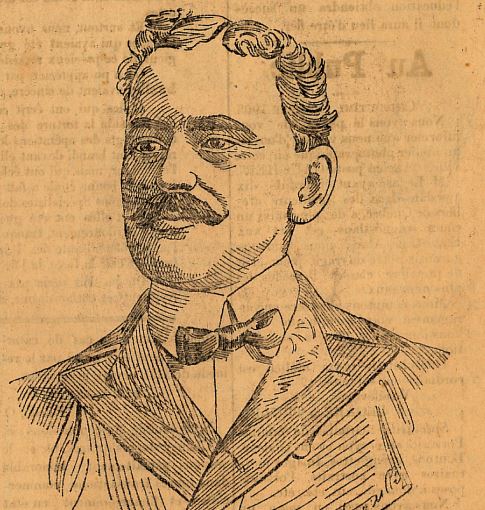
The establishment of Alcoa and other industries in the area would not have been possible without the knowledge of the region and its industrial potential. Indeed, the Beemer Hotel in Roberval and the Château Saguenay in Chicoutimi attract a wealthy and cosmopolitan clientele. However, well aware of the wealth of the region, Joseph-Dominique Guay and other businessmen, including Julien-Édouard-Alfred Dubuc, develop an economic promotion plan to attract investors. They launch an advertising campaign praising the advantages for industries to establish themselves in the Saguenay region. In addition to advertising in various Quebec newspapers, they travel to Montreal, Sault Ste. Marie and New York. Dubuc also maintains correspondence with German, British and English Canadian engineers and industrialists.
In the face of unsuccessful efforts, and under the guidance of Dubuc, the businessmen decide to invest their own capital in the creation of regional businesses. The Chicoutimi Pulp Company is created. In order to reduce the costs associated with transporting the pulp and to facilitate its movement, infrastructure is put in place. Through the Ha! Ha! Bay Railway Company (which would later become Roberval-Saguenay), the pulp mill is connected to Bagotville. Given the ever-increasing demand for newsprint, Dubuc commences production of sulphite pulp in Port-Alfred. It is in this context that the port facilities at the mouth of the À Mars River are put in place.
Once Alcoa is established, Dubuc is forced into bankruptcy. The Aluminum Company of America acquires the Roberval-Saguenay Railway as well as the port facilities. Subsequently, the company proceeds with major undertakings.
https://youtu.be/P_iQmRtfnzQ
A privileged region
By the end of the 19th century, studies are carried out that reveal the region’s vast hydroelectric potential. Persuaded that the development of water resources will lead to regional development and, by the same token, prosperity, the politician Louis-Alexandre Taschereau puts in place a policy favourable to foreign investment. It is in this context that the development of the large hydroelectric dams in the Saguenay-Lac-Saint-Jean region takes place.
Isle-Maligne
Impressed by the hydroelectric potential, James Buchanan Duke, an American tobacco magnate, purchases the Grande Décharge water rights following his visit to the area in 1912. Duke creates a Canadian company, the Quebec Development Corporation. However, the lack of demand delays his plans. Hoping to build a second pulp and paper mill not far from Alma, Sir William Price acquires 25% of the shares of Quebec Development Corporation in 1920. Together, Duke and Price establish the Duke-Price Power Company and begin construction of the Isle-Maligne hydroelectric power plant.
The work, which begins in the winter of 1924, was carried out by a large number of workers recruited from all over. Cofferdams are set up to dry the site. Not far from the site are a carpentry shop, a machine shop, a sawmill, two crushers and a cement mixer as well as sand and gravel pits. The first of the eight generators is commissioned on 24 April 1925. It is followed closely by the others. The electricity required by Price Brothers is only a fraction of the plant’s capacity. The largest hydropower plant in the world has the capacity to supply electricity to a future customer.
A vast hydroelectric potential
Shipshaw I
Following the association between James Buchanan Duke and Arthur Vining Davis, the Aluminum Company of America (Alcoa) is established in the Saguenay region. The Isle-Maligne generating station allows construction of the smelter, meeting its initial needs. Upon arriving in the region, Alcoa projects construction of a power plant at Chute-à-Caron. It is planned to divert the waters of the Saguenay River to the Shipshaw River through an artificial canal and to construct a hydroelectric generating station at the mouth of the Shipshaw River. The project appears monumental and expensive: it is therefore divided into two stages.
Work begins in 1926. The river proves to be an obstacle due to its considerable volume and extremely rapid flow, as well as its steep banks. Traditional techniques prove ineffective. James W. Rickey, chief hydraulic engineer, has the idea of building a massive obelisk out of solid concrete, one of the sides perfectly matching the river bed, then tipping it into place. This concrete structure measures 28 metres in height and weighs 10,000 tonnes. This feat, unique in the world, attracts many curious people to the region. The Chute-à-Caron power station enters service in January 1931.
Shipshaw II
The second stage of the project is forgotten for a while. The increasing demand for aluminum during the Second World War leads the Aluminum Company of Canada to expand its aluminum smelter, thus requiring more energy. It is in this context that the second phase of development of the Shipshaw complex begins. More than 10,000 men work in construction, which begins in 1941. The first two generators start in November 1942, followed by the other 10 at regular intervals.
A promising site
In April 1925, Edwin S. Fickes, Alcoa’s chief engineer, and Irving W. Wilson arrive in the area to establish the exact location where the aluminum smelter will be built. Three sites are considered: Saguenayville, Ha! Ha! Bay, and “Le Redan” Plateau. Located halfway between Chicoutimi and Jonquière, “Le Redan” Plateau, now known as Arvida, is the most strategic location for the construction of the plant.
This location is chosen for several reasons. The site, which has several plateaus, proves ideal for the construction of the smelter and the city. Also, the area is close to the future power plant that Alcoa plans to build at Chute-à-Caron. In addition, the proximity to the port at Ha! Ha! Bay and the presence of the Roberval-Saguenay and Canadian National Railways influence the company’s decision to choose Arvida as the location for the new plant.
In August 1925, meetings are held with the farmers whose farms are on the site chosen by Alcoa. These meetings are aimed at explaining the project and the company’s intentions. Some 60 farms are purchased. Alcoa invests over $1 million to acquire 2,400 hectares.

